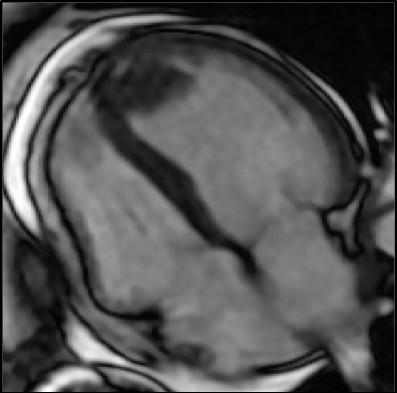For Cardiac Tumors, CMR Proves Powerful for Predicting Mortality
Chetan Shenoy calls the imaging a “one-stop shop” for the assessment of patients with suspected cardiac malignancies.

In patients with suspected cardiac tumors, cardiovascular magnetic resonance (CMR) imaging can accurately provide diagnosis and guide clinical management, according to new multicenter data. Moreover, CMR findings can independently predict long-term mortality above traditional risk factors.
“Our findings show that CMR should be the imaging modality of choice for the assessment of patients with suspected cardiac tumors, and physicians can use it as the only imaging test for virtually all patients—a ‘one-stop shop’—that provides accurate data on diagnosis and prognosis,” lead author Chetan Shenoy, MBBS, MS (University of Minnesota Medical Center, Minneapolis), told TCTMD in an email.
Clinicians can now confidently make patient decisions based on a CMR diagnosis, he continued. “Patients with no mass or pseudomass can be reassured, patients with thrombus can be anticoagulated, patients with a benign tumor may undergo surgery to remove it or may be monitored over time (depending on what the tumor is, where it is, etc), and those with a malignant tumor may be treated with biopsy (to know the specific subtype of malignancy), surgery, chemotherapy, radiation therapy, or palliation only.”

Commenting on the study for TCTMD, Jiwon Kim, MD (NewYork-Presbyterian/Weill Cornell Medical Center, New York, NY), said “the big-picture message that this paper highlights in a systematic fashion is that MRI is highly diagnostically powerful as well as prognostically useful.” The results demonstrate “validation of the CMR technique in evaluating patients with suspected cardiac masses in a real-world setting,” she added.
Once considered more of a niche imaging modality, CMR has become more widely available in recent years for tumor assessment in the United States, Kim explained. Some issues regarding preauthorization and reimbursement still remain, but expertise has grown and safer contrast agents have enabled more patients to be imaged with CMR.
CMR Results
For the study, published online last week ahead of print in the European Heart Journal, Shenoy and colleagues included 903 patients (median age 60 years; 46% men) from four US centers who were referred to CMR for suspected cardiac tumor between 2003 and 2014. There was a high prevalence of cardiac risk factors including 59% of patients with hypertension, 40% who were smokers, and 27% with CAD. About one-third (32%) had known extracardiac malignancy. Most (78%) had undergone echocardiography prior to being referred to CMR, while 25% had CT. All patients were scanned on 1.5 or 3T scanners (Siemens) with a standardized protocol as defined by the Society for Cardiovascular Magnetic Resonance, and the images were interpreted by experienced CMR physicians.
CMR diagnosed 25% of patients as having no mass (any structure that could have been mistaken for a mass in prior imaging), while 16% had pseudomass (prominent normal structure, variant of a normal structure, or nonmass pathology), 16% thrombus, 17% benign tumor, and 23% malignant tumor. Patients with a CMR diagnosis of malignant tumor had the highest prevalence of extracardiac malignancy, and over one-quarter (26%) had no known cancer at the time of CMR.
Over a median 4.9 years, the CMR diagnosis was accurate in 98.4% of patients. Among the 376 patients who died, those who had CMR diagnoses of thrombus (36%) and malignant tumor (73%) had the highest estimated cumulative 5-year mortality rates while rates were roughly similar—and lower—in those with pseudomass (26%), benign tumor (17%), and no mass (22%).
Independent predictors of mortality on Cox proportional hazards regression analysis included higher age (HR 1.09 per 5-year increase; 95% CI 1.04-1.13), smoking (HR 1.37; 95% CI 1.11-1.69), reduced LVEF on CMR (HR 1.05 per 5% decrease; 95% CI 1.01-1.10), extracardiac malignancy (HR 2.32; 95% CI 1.81-2.97), thrombus (HR 1.46 vs no mass; 95% CI 1.00-2.11), or malignant tumor (HR 3.31 vs no mass; 95% CI 2.40-4.57). Also, a CMR diagnosis of malignant tumor predicted mortality regardless of known prior cancer.
Lastly, the addition of CMR diagnosis proved to add incremental value to a model based on clinical variables alone (P < 0.001) in patients with and without extracardiac malignancy.
Guidance Document Needed
“We knew from small studies that CMR performed well for this purpose, but we were amazed at how well it performed in a large, real-world, multicenter setting,” Shenoy said. “When we did the study, we were also struck that many patients were referred for a suspected cardiac tumor in the setting of known cancer outside the heart but ended up with a variety of findings in the heart.”
Prior to this study, it was unknown whether a mass could be ignored based on CMR alone, he explained. The researchers provide the algorithm they use to make diagnoses—something not previously available—and Shenoy said he hopes it will be “useful to CMR trainees and practicing CMR physicians.”
Additionally, he said he would like to see their findings “serve as the evidence for stronger recommendations in future consensus documents and guidelines on this topic.”
Kim agreed that societal guidance is missing in this space, especially since advances in echocardiography have resulted in more masses and pseudomasses being identified. “I do think having a consensus document or statement could be helpful for clinicians to better understand the tools that currently exist to improve our diagnostic and prognostic ability, to review strengths and weaknesses of existing modalities, and help determine when we choose one modality versus another,” she said, adding that she expects such a publication soon.
Going forward, Shenoy called for more research with newer CMR techniques like T1 and T2 mapping. “However, we do not anticipate they will add much value simply because our data show that CMR performs very well even without the new techniques and there is little room for further improvement,” he said.
Kim added that it would be helpful to delve deeper into “discerning whether mortality was due to the cardiac tumor itself.” But also, she said, looking at T1 and T2 mapping techniques could “provide additional tissue characterization, and I think studying the value of those techniques in cardiac masses could be quite interesting.”
Yael L. Maxwell is Senior Medical Journalist for TCTMD and Section Editor of TCTMD's Fellows Forum. She served as the inaugural…
Read Full BioSources
Shenoy C, Grizzard JD, Shah DJ, et al. Cardiovascular magnetic resonance imaging in suspected cardiac tumour: a multicentre outcomes study. Eur Heart J. 2021;Epub ahead of print.
Disclosures
- The study was supported by the National Institutes of Health.
- Shenoy and Kim report no relevant conflicts of interest.




Comments